AUDIO FIX: HIGH FREQUENCY ARTIFACT
PROBLEM
Track was recorded via Ringr and “it sounds like the guy is scribbling the entire time he is speaking.”

ORIGINAL AUDIO
ASSESSMENT
I think the first order of business is to figure out what caused this high frequency artifact problem as seen in the above waveform sample of a speaking part. The waveform has obvious corruptions in it. Because the artifact appears only during speaking parts, it could be that the problem is in the Ringr’s electrical system or carrier system. There might be an issue with any gating system used by Ringr or the carrier. In our experience, when we’ve had similar issues whenever we’ve used compressors and noise gates to heavily, especially in noisy environments.
It should be asked why the sound issue was not discovered during the recording process. In our experience, it could be that this voice track was not monitored at all or that the monitor audio was too low to hear that there was a problem. It could be that whatever monitor speakers or headphones were used, they had a less than flat freq response so that these high frequencies we not easily heard. This is a problem when people use music or noise cancelling headphones; they have skewed frequency response curves, and give less than accurate indications.
Most often when a sound issue arises over telephonic or internet systems, the problem can be solved by reconnecting the call until a better connection is established–sometimes this takes several tries. More about solutions below . . .
THE FIX
EQ HIGH END ROLL OFF METHOD
- Use a graphic equalizer or movable curves to sweep the audio to locate the problem frequency(ies).
- Either use a notch filter to cut out the problem frequencies or use the high-end roll off method if broad band reduction is necessary. This is what we used here.
- Now that most of the high-end artifact is diminished, continue to adjust EQ curve if necessary. We added a little mid-range boost to compensate for some of the high-end air or sheen that was lost.

AUDIO FIX: HIGH END ROLL OFF
INVERSION + LPF METHOD
- Use a graphic equalizer or movable curves to sweep the audio to locate the problem frequency(ies).
- Duplicate the original track (in red), invert it, and apply a low pass filter to the inverted track. Because the two tracks are 180 degrees out of phase, they cancel each other out except for the frequencies allowed by the LPF (up to about 4.5kHz). High frequencies above this point are cut.
- Note: The high end roll off in method 1 and the LPF in method 2 function identically, but note the slope of the LPF is the opposite of the high pass roll off slope above. We think this yields less high-end air/sheen, but adjust as necessary.
- Now that most of the high-end artifact is diminished, continue to adjust EQ curve if necessary. This sample could use a little high end enhancement.

AUDIO FIX: INVERSION + LPF
CONCLUSION
Here’s a more exemplary A/B demonstration of our fix. We think it works well.
Here are a few more suggestions:
- As mentioned above, these issues can often be discovered and remedied during the field recording stage–better there than in post.
- While recording, always monitor audio tracks and mixes (preferably at the recorder) with good studio or headphone monitors with a flat frequency response.
- If a telephonic or internet platform is giving you problems retry the connection repeatedly.
- If a platform is giving you consistently poor audio, ditch it.
- There’s always a risk when using inboard compressors and noise gates (e.g., in the field and/or before the recorder), especially if they are not set properly. As mentioned, we’ve had similar “tin rattling” artifacts whenever we’ve used heavy compression and gating. Constant background sound, especially A/C, machinery, and electrical hums get let into voice segments as noise gates open and close, and if their particular frequencies get distorted through dynamic processing, then they are “baked” into the track. One very common issue to avoid is over compressing telephone or internet calls, which often creates an “underwater” quality to the audio. So, a good rule is to use such effects as lightly as possible in the field to avoid baking these artifacts into your tracks.
- Above all else, trust your ears. And consider this: You or the people working on your audio may have hearing issues that factor into these problems–so be aware of this most basic variable.
You must be logged in to post a comment.